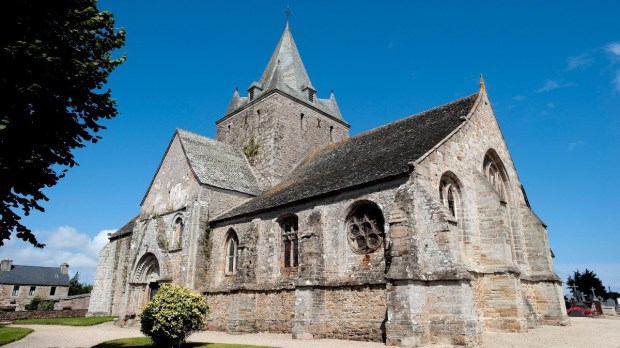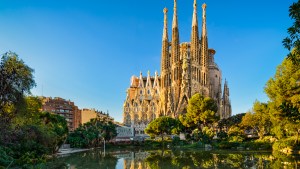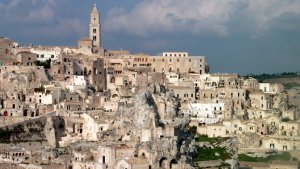Everything is shadows and mysteries around this ancient sanctuary of the village of Lanmeur in Finistère. The place is surrounded by tragic legends, and local lore holds that on the day of the end of the world, which is said will take place on a Trinity Sunday, it will be the last possible refuge offered to survivors. Kernitron means, in Breton, “the domain of the Lady.” It is generally believed that this lady is the Virgin Mary, Itron Varia, but again, nothing is certain. Some maintain that it is rather a Breton princess, Tryphine de Vannes, whose tragic destiny is closely linked to Lanmeur. But, as is often the case in these countries with a very long memories, references to myths from before the Flood, a flood, precisely, at the heart of our history are part of the Notre-Dame de Kernitron story.
The lost homeland of the Bretons
This story begins around the fifth century. At that time, what is known today as Brittany, a Celtic land that had been a Roman province for more than four hundred years and had been Christianized for almost as long, met a disastrous fate. As the barbarian hordes swept through the Empire and Italy itself was no longer safe, Emperor Valentinian III – whose courage was not his dominant virtue – decided to cut his losses. In order to protect himself and his capital of Ravenna, he made an attempt to repatriate the legions of Brittany, abandoning the island.
The Bretons, brave warriors organized in militias, tried to defend themselves but, despite their heroism, they were overwhelmed by attacks from Ireland and Scotland, but also from Saxony and other regions of northern Germania. From the 450s onwards, massive arrivals of Germanic settlers succeeded the looting raids, driving the Bretons out of their homes, killing those who resisted and trying to impose on these fervent Catholics a brutal return to paganism. If some fled to the mountains of Wales, the majority, in order to save their greatest treasure, their faith, chose exile. Abandoning everything, they embarked for Gallic Armorica (the name given in ancient times to the part of Gaul between the Seine and the Loire that includes the Brittany Peninsula) and Spain. These regions were also devastated during the great invasion of the winter of 405, and whose native populations, massacred, had almost disappeared. Thus the new Celtic lands, the small Armorican Brittany and Galicia, were born.
Little by little, the ruins are raised
Some of these emigrants set foot on the coast of northern Finistère, and were entrusted by the patrician Aetius, “the last of the Romans,” a magnificent statesman and general who stopped Attila’s advance in 451, to guard this threatened coastline. This portion of Armorica was renamed Domnonea by the colonists, after their lost homeland.
Little by little, they discover ruins, including a Roman military fort next to an immemorial place of worship, a thermal complex built around a sacred spring. There are many such springs in the region, but this one has a strange peculiarity: we don’t know its source. Even more mysteriously, there’s no clear flow, which has led researchers to ask where the water goes. Even stranger, at certain times, this water, with a constant flow, even when it is very hot, inexplicably rises and floods not only its basin but everything around it, before disappearing…
The terrifying fountain
One tradition explains that this water travels by underground conduits, from the bottom of the ocean, and this is why it does not dry up. But for the Celts the existence of a marine spring overflowing on the continent is terrifying. Celtic mythology has a tradition that Christianity has not eradicated: while elsewhere many believe that the world will end in a general conflagration, the Celts believe that it will be relentlessly submerged by the rising seas. This spring would thus be one of the valves destined to open on the last day.
What else could be done to avert the catastrophe, or at least delay it, but to pray? The Bretons did so and built, no doubt under the direction of the future Saint Samson, the Welsh-born founder of the bishopric of Dol, a huge monastery which gave its name to the place: Lann meur, the “great monastery.” This place of prayer disappeared in the 9th century, during one of the bloody Viking attacks that ravaged Brittany. It was never rebuilt but left its name to the neighboring village, Lanmeur. The spring has not disappeared. It was just covered by the parish church, Saint-Mélar, and buried in its crypt. This does not ward off the threat. Sooner or later, when the trumpets of the Judgment sound, on the Day of wrath marked by God from all eternity, the ocean lock will give way.
A Norman architect
During an age of anguish, gripped by apocalyptic claims as the Year 1000 approached, the villagers turned to the only one who could help them, Mary, the supreme Advocate. Or was it simply a demonstration of Marian piety typical of the great religious boom of the 11th-12th centuries, which saw Europe covered with a “white coat of new churches”? What is certain is that between the 11th and 15th centuries, Lanmeur acquired a second sanctuary dedicated to Our Lady in this place called Kernitron. The term chapel is misleading as regards the size and opulence of the building. No expense was spared to build it, stone from Normandy was even used instead of local materials. Similarly, an architect from the same region had to be called in, since the building has obvious Norman influences that are unique in Brittany and give this Romanesque complex its unique appearance.
Who was behind the project? The Templars of the neighboring commandery, then the Benedictines of the Abbey of Saint-Jacut, who continued the work after the fall of the military order, when they inherited its property. Was it to counteract these “foreign” influences, at a time when the Breton duchy was struggling to preserve its independence, or was it because of the resurgence of a pagan cult that had not yet been eradicated, that another feminine figure came to mingle with, if not replace, that of Notre-Dame? It is possible.
The murdered prince
Lanmeur, once an important city, when the Domnonée was an essential political component of a rising Breton kingdom, was at the center of several dramas linked to local dynasties. First, there was the assassination of the young prince Mélar, the very one who, canonized by popular fervor, gave his name to the town’s church. Heir to the throne of Cornwall after the premature death of his father, Melar, in 531, still a child, was excluded from the succession by his uncle.
In the interest of the country and the dynasty, one prefers to leave the crown to a man able to carry weapons and to defend the common interests, rather than to respect the rights of a young heir. Usually, in order to avoid any future challenge, the adult kills the child. If he is of a sensitive nature, he may be content to lock him up in a monastery, but experience shows that a prince locked up against his will becomes a dangerous rival as he grows up. Better to kill him. The officer in charge of liquidating the little Mélar did not have the courage. Feeling pity, in a manner of speaking, he limited himself to cutting off his right hand, the hand that holds the sword, and his left foot, without which the boy could no longer ride a horse. Thus mutilated, Mélar would never be able to reign, since the strength and prosperity of the whole country depend on the physical integrity of the king.
Did the executioner lie and not inflict these ritual amputations on the child? Or did Melar benefit, as his legend says, from a miracle that gave him a silver hand and a silver foot? Whatever the case, learning that his nephew was fit to claim the crown, the king had him murdered, for good this time, in the house of Lanmeur where he had taken refuge. And it is in the church that he was buried, at the request of another of his uncles, Conomor de Cornouaille, eager to use this drama to recover the crown for his own benefit.
The true Lord of Kernitron
Conomor was no saint. Married four times, he murdered each wife when she became pregnant for the first time, because a soothsayer told him he would have a son who would kill him. This did not prevent the Count of Vannes, Waroc’h, from granting the hand of his daughter, Tryphine, to this serial killer. When the young woman became pregnant, Conomor beheaded her, but Saint Gildas resurrected the dead woman, to allow her to give birth to her son. Folklorists see in her story the resurgence of pagan beliefs, Tryphine incarnates the divinity of the dawn or of the spring, who crosses the darkness of night and winter to come back to life, with the help of the first four wives of Conomor, an archaic figure of Evil, who represent the four elements: water, air, fire and earth.
In any case, these two dramas, with unclear circumstances, have left their mark on local memory, to the point that Saint Tryphine may have overshadowed Our Lady, the true Queen of Kernitron. But not to the point of overshadowing her protective role. While the faithful no longer go to Kernitron, seeking Our Lady to hold back the floods of the last day, the chapel of Lanmeur always attracts crowds to its pardon, a traditional Breton pilgrimage, on August 15.



